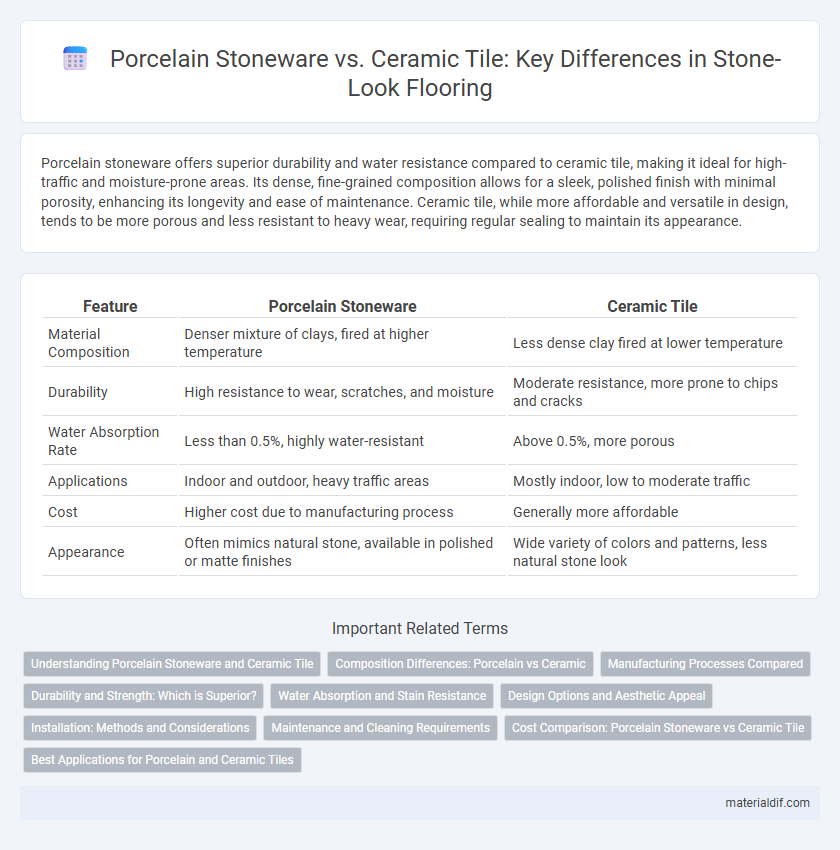Porcelain stoneware offers superior durability and water resistance compared to ceramic tile, making it ideal for high-traffic and moisture-prone areas. Its dense, fine-grained composition allows for a sleek, polished finish with minimal porosity, enhancing its longevity and ease of maintenance. Ceramic tile, while more affordable and versatile in design, tends to be more porous and less resistant to heavy wear, requiring regular sealing to maintain its appearance.
Table of Comparison
| Feature | Porcelain Stoneware | Ceramic Tile |
|---|---|---|
| Material Composition | Denser mixture of clays, fired at higher temperature | Less dense clay fired at lower temperature |
| Durability | High resistance to wear, scratches, and moisture | Moderate resistance, more prone to chips and cracks |
| Water Absorption Rate | Less than 0.5%, highly water-resistant | Above 0.5%, more porous |
| Applications | Indoor and outdoor, heavy traffic areas | Mostly indoor, low to moderate traffic |
| Cost | Higher cost due to manufacturing process | Generally more affordable |
| Appearance | Often mimics natural stone, available in polished or matte finishes | Wide variety of colors and patterns, less natural stone look |
Understanding Porcelain Stoneware and Ceramic Tile
Porcelain stoneware is a dense, vitrified material fired at higher temperatures, resulting in greater durability, water resistance, and stain resistance compared to ceramic tile, which is more porous and fired at lower temperatures. Both materials originate from clay but differ in composition, with porcelain containing refined clays and silica that enhance strength and aging performance. These characteristics make porcelain stoneware ideal for high-traffic areas and exterior applications, while ceramic tiles suit moderate-use indoor environments.
Composition Differences: Porcelain vs Ceramic
Porcelain stoneware is composed of finer, denser clay and is fired at higher temperatures compared to ceramic tile, resulting in greater durability and water resistance. Ceramic tiles are made from a mixture of red or white clay combined with other natural materials, fired at lower temperatures, making them more porous and less resistant to wear. The mineral composition and firing process distinctly affect the strength, porosity, and application suitability of porcelain versus ceramic tiles.
Manufacturing Processes Compared
Porcelain stoneware is produced using a highly refined clay mixture fired at temperatures above 1200degC, resulting in a dense, vitrified surface with superior durability and water resistance. Ceramic tiles undergo a less intense firing process, typically between 1000degC and 1150degC, which makes them more porous and less robust compared to porcelain. The advanced manufacturing process of porcelain stoneware ensures a harder, more wear-resistant finish ideal for high-traffic areas and outdoor applications.
Durability and Strength: Which is Superior?
Porcelain stoneware exhibits superior durability and strength compared to ceramic tile due to its denser composition and lower water absorption rate, typically below 0.5%. This makes porcelain highly resistant to wear, scratches, and moisture, ideal for high-traffic and exterior applications. Ceramic tiles, while cost-effective and versatile, are generally less dense with higher porosity, resulting in reduced toughness and susceptibility to chipping over time.
Water Absorption and Stain Resistance
Porcelain stoneware exhibits significantly lower water absorption rates, typically below 0.5%, compared to ceramic tiles which can absorb up to 7%. This low porosity of porcelain enhances its stain resistance, making it ideal for areas prone to moisture and spills. Ceramic tiles, with higher absorption, are more susceptible to staining and require additional sealing to maintain durability.
Design Options and Aesthetic Appeal
Porcelain stoneware offers a wider range of design options compared to ceramic tile, featuring high-resolution digital printing technology that mimics natural stone, wood grain, and intricate patterns with exceptional detail. Its denser composition enhances color vibrancy and surface finish, providing a luxurious, polished aesthetic that remains consistent over time. Ceramic tile, while versatile, often presents fewer design variations and less depth in texture, making porcelain stoneware the preferred choice for sophisticated, modern interior design projects.
Installation: Methods and Considerations
Porcelain stoneware requires a more meticulous installation process due to its density and hardness, often necessitating specialized diamond-tipped tools and a stronger adhesive compared to ceramic tile. Proper subfloor preparation is critical for both materials, but porcelain demands a flatter and more stable base to prevent cracking. Seam alignment and grout selection also play crucial roles, with epoxy grouts preferred for porcelain to enhance durability and resistance to stains.
Maintenance and Cleaning Requirements
Porcelain stoneware offers superior resistance to stains, scratches, and moisture compared to ceramic tiles, making it easier to maintain with simple sweeping and mopping routines. Its dense, non-porous surface prevents dirt accumulation and reduces the need for harsh chemical cleaners, unlike ceramic tiles that may require more frequent sealing and grout maintenance. Porcelain's durability ensures long-lasting appearance and minimal upkeep, ideal for high-traffic areas or environments prone to spills.
Cost Comparison: Porcelain Stoneware vs Ceramic Tile
Porcelain stoneware typically costs between $3 and $10 per square foot, reflecting its durability and low porosity compared to ceramic tile, which ranges from $1 to $5 per square foot. The installation costs for porcelain stoneware are generally higher due to its density and hardness, requiring specialized tools and more labor time. Overall, porcelain stoneware offers a longer lifespan and better resistance to wear, justifying its higher upfront and installation expenses compared to more affordable ceramic tiles.
Best Applications for Porcelain and Ceramic Tiles
Porcelain stoneware offers superior durability and water resistance, making it ideal for high-traffic commercial areas, outdoor spaces, and wet environments like bathrooms and kitchens. Ceramic tiles, with their softer composition and wide range of decorative finishes, are best suited for low-traffic residential walls, backsplashes, and indoor areas with minimal moisture exposure. Both materials provide versatile design options, but porcelain's density ensures better performance under heavy use and harsh conditions.
Porcelain Stoneware vs Ceramic Tile Infographic

 materialdif.com
materialdif.com